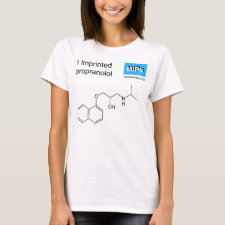
Authors: Chen ZY, Ye L
Article Title: Controlling size and uniformity of molecularly imprinted nanoparticles using auxiliary template.
Publication date: 2012
Journal: Journal of Molecular Recognition
Volume: 25
Issue: (6)
Page numbers: 370-376.
DOI: 10.1002/jmr.2161
Abstract: Molecularly imprinted nanomaterials are gaining substantial importance. As a simple and efficient synthetic method, precipitation polymerization has been used to prepare uniform molecularly imprinted microspheres for numerous template compounds. Despite of its general applicability, the difficulty of obtaining uniform particles for some difficult templates by precipitation polymerization has been reported. In this work, we attempted to produce uniform atrazine-imprinted nanoparticles using propranolol as an auxiliary template under standard precipitation polymerization condition. When propranolol was added in the prepolymerization mixture for atrazine imprinting, it displayed a significant effect on particle size and size distribution of atrazine-imprinted polymers. The molecular binding characteristics of the molecularly imprinted polymer (MIP) nanoparticles were found to be dependent on the relative ratios of the two templates. Under an optimal template propranolol - atrazine ratio of 1:3 mol/mol, very uniform imprinted nanoparticles (dH = 106 nm) with a polydispersity index of 0.07 were obtained. The loading of the auxiliary template (propranolol) could be reduced to as low as 5% without sacrificing the uniformity of the MIP nanoparticles. The uniform MIP nanoparticles could be easily encapsulated into polyethylene terephthalate nanofibers using a simple electrospinning technique. The composite nanofibers containing the MIP nanoparticles maintained specific molecular binding capability for both atrazine and propranolol. Copyright © 2012 John Wiley & Sons, Ltd
Template and target information: propranolol, atrazine, auxiliary template
Author keywords: molecular imprinting, Nanoparticle, precipitation polymerization, electrospinning, nanofiber



Join the Society for Molecular Imprinting

New items RSS feed
Sign-up for e-mail updates:
Choose between receiving an occasional newsletter or more frequent e-mail alerts.
Click here to go to the sign-up page.
Is your name elemental or peptidic? Enter your name and find out by clicking either of the buttons below!
Other products you may like:
 MIPdatabase
MIPdatabase









